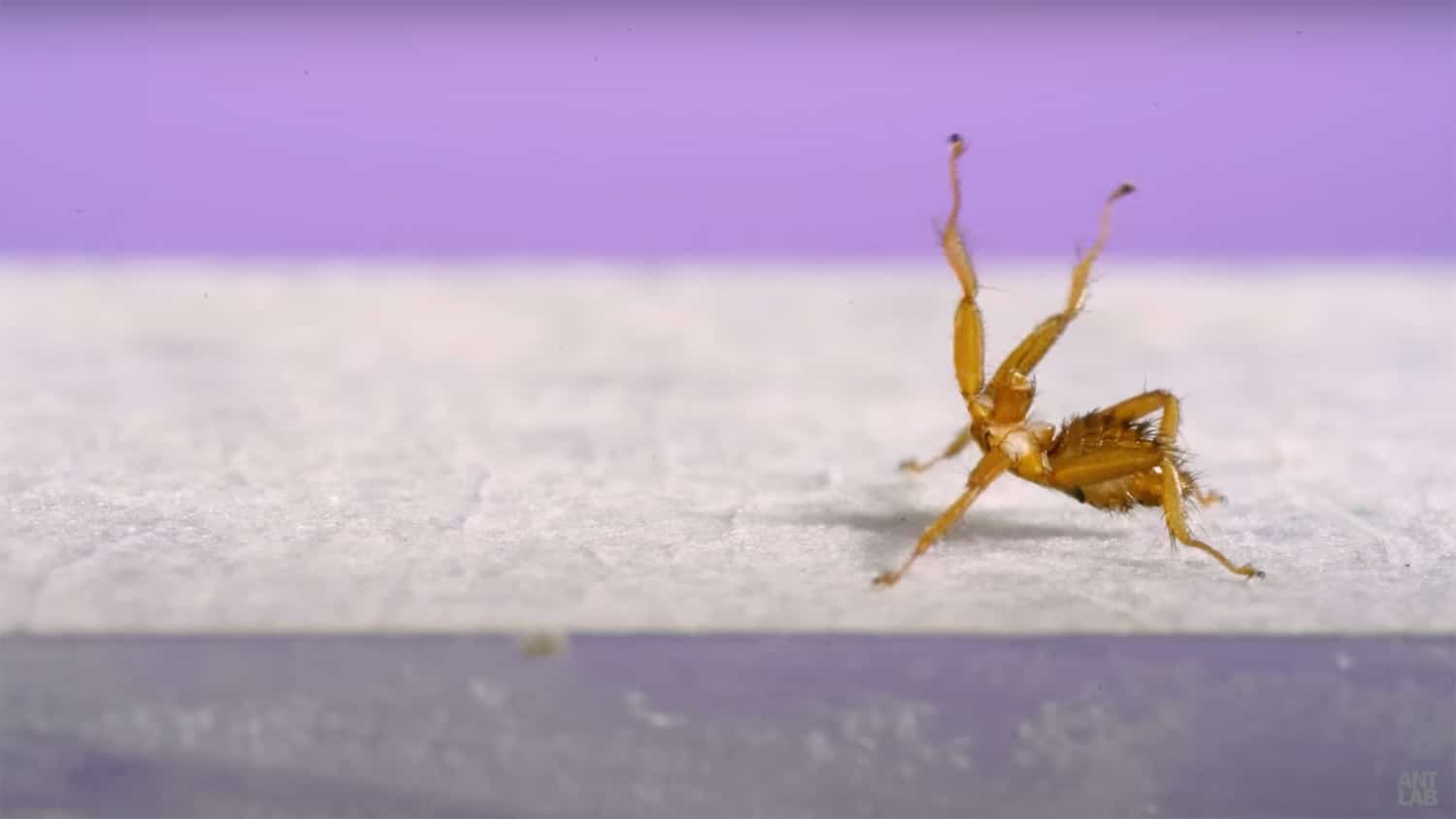Museum Partnership Invites the Public Into Research
When people visit museums, they get to see scientifically, culturally and historically significant specimens and artifacts that have been preserved through the ages. But they rarely get to see the active research constantly taking place within their walls. NC State and the North Carolina Museum of Natural Sciences (NCMNS) decided to change that.
In 2012, they hired the first jointly appointed faculty member as part of an innovative partnership that would allow NC State faculty to conduct research in open-to-the-public settings at the museum. Today, there are six joint-appointed faculty. They split their time between teaching at NC State and making discoveries at the museum as visitors peer into their glass-walled labs.
On your next visit to the natural sciences museum in downtown Raleigh, you’ll cross paths with everything from mighty dinosaurs to crawling insects — and the NC State scientists that study them.
Meet the Joint-Appointed Faculty
- Paul Brinkman, teaching associate professor in NC State’s Department of History (College of Humanities and Social Sciences), and head of the Environmental Humanities Research Lab and curator of special collections at the museum
- Lily Hughes, research assistant professor in NC State’s Department of Marine, Earth and Atmospheric Sciences (College of Sciences) and curator of ichthyology at the museum
- Roland Kays, research professor in NC State’s Department of Forestry and Environmental Resources (College of Natural Resources) and director of the museum’s Biodiversity Research Lab
- Liz Kierepka, assistant research professor in NC State’s Department of Forestry and Environmental Resources (College of Natural Resources) and senior scientist at the museum’s Biodiversity Research Lab
- Adrian Smith, research assistant professor in NC State’s Department of Biological Sciences (College of Sciences) and head of the museum’s Evolutionary Biology and Behavior Research Lab
- Lindsay Zanno, associate research professor in NC State’s Department of Biological Sciences (College of Sciences) and head of paleontology at the museum
Brinkman and Zanno: Digging Up Dinosaur History
Sixty-seven million years ago, a tyrannosaur and a Triceratops became entangled and entombed together on land located in modern-day Montana. Today, they’re at NCMNS, where they’ll spend the next five years being studied by paleontologist Lindsay Zanno and her team.
The fossils will be part of a first-of-its-kind open lab experience called “Dueling Dinosaurs,” slated to open to the public on April 27. Found by private citizens in 2006 in the Hell Creek Formation in Montana, the fossils are unprecedentedly well preserved and could help paleontologists answer some of the most pressing questions about dinosaurs.
“These animals were buried as carcasses with all their soft tissues on, and so every bone in their body is in place as it would’ve been in life. But also, these are two animals — predator and prey — that were buried together in a single moment in time, back in the Cretaceous,” Zanno said.
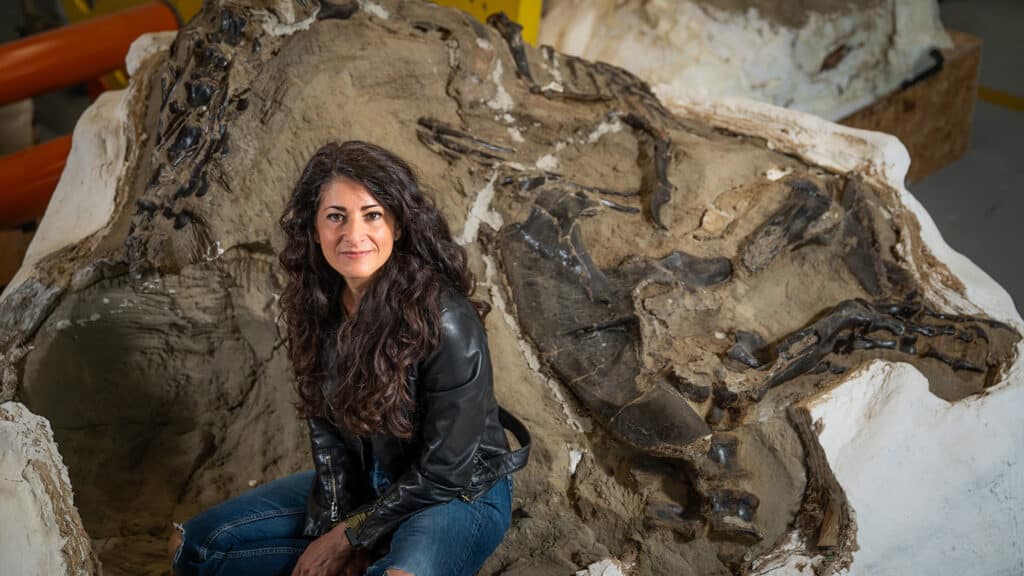
Historian of science Paul Brinkman, whose expertise is in 19th and 20th century vertebrate paleontology and geology, has a special appreciation for the “Dueling Dinosaurs” fossils.
“When people ask me what I do, I usually say I write books about people who write books about dinosaurs. But I’ve also done a lot of dinosaur field work myself,” Brinkman said. “I was out in Montana doing field work during the summer of 2006, when the ‘Dueling Dinosaurs’ fossils were found, and so I went to see them. I was blown away. I had worked with Sue the Tyrannosaurus rex at the Field Museum of Natural History. That’s currently the most complete T. rex in the world, so I’ve seen some nice dinosaurs. The ‘Dueling Dinosaurs’ specimens are spectacular. I don’t know that I’ve ever seen a more amazing tyrannosaur than that one.”
Zanno and her team will first study the specimens to uncover the physical characteristics, diet, age and cause of death of the dinosaurs. They’ll also try to determine what kind of interaction the tyrannosaur and the Triceratops were having when they died. The paleontologists will then see if the specimens can help them answer bigger-picture questions about the biodiversity and ecosystem in North America before the mass extinction event.
Zanno wants the public to be involved every step of the way. As part of the interactive “Dueling Dinosaurs” exhibit, visitors will get to walk into the lab and watch the team of paleontologists make discoveries in real time. There will also be a member of the paleontology team on hand at all times to answer visitor questions.
“What is so special about these fossils, from my perspective, is that they allow us to teach the public about the process of science,” she said.

Of course, one-of-a-kind fossils called for a one-of-a-kind research lab.
“We’ve spent many years designing incredible interactive experiences, starting with the lab itself,” Zanno said. “We decided we were going to get rid of the glass altogether, and we were going to invite the public to come inside the lab space itself. As far as I know, that’s never been done anywhere in the world. This is the first open-access science lab of its kind.”
Museum visitors will also get to do hands-on paleontology work themselves. Next to Zanno’s research lab is a replica of it, in which visitors can try their hand at activities like running CT scans on fossils and reconstructing soft tissues like the inner ear.
“The public learns how we use that information to determine what frequencies a dinosaur could hear 66 million years ago,” Zanno said.
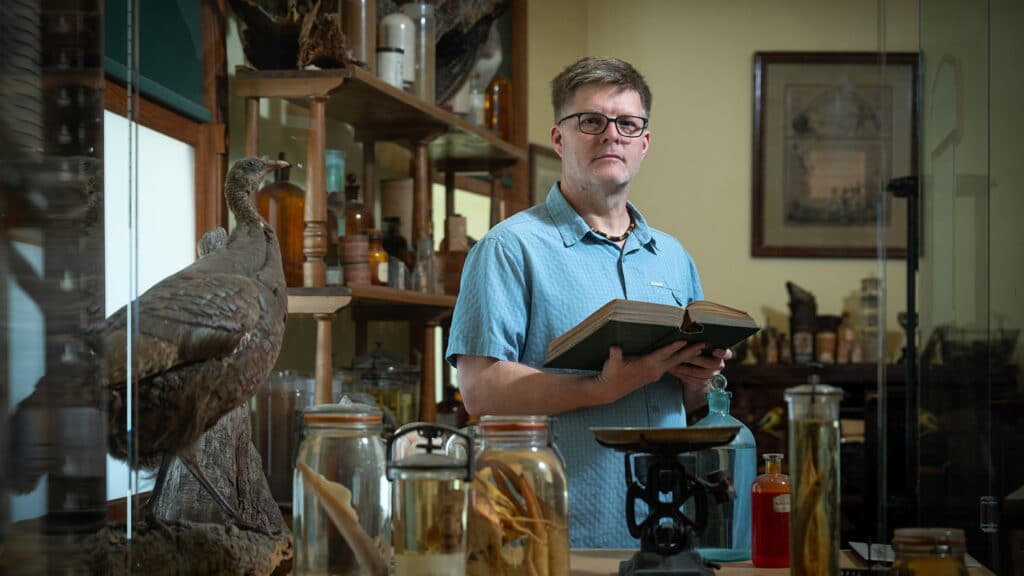
With its innovative and interactive features, “Dueling Dinosaurs” is positioned to set a new standard for dinosaur exhibits and public engagement. Dinosaurs are staples in natural science museums nowadays, but prior to the turn of the 20th century, that wasn’t the case.
“We all take it for granted that you can go to any natural history museum and see a dinosaur. There was a time when they weren’t in museums at all, because they were so impractical to display,” Brinkman said. “At the turn of the 20th century, a group of young paleontologists solved these logistical problems, like, ‘How do you mount 900-pound bones into a lifelike skeleton for people to see?’ And without a bunch of scaffolding that’s going to make the exhibit look unattractive.”
“Dueling Dinos” is a prime example of how the jointly appointed positions allow the faculty to raise the bar on their research possibilities. At the same time, the public — and the NC State students that work under the faculty — get an insight into the scientific research process that they can’t find anywhere else.
“These joint-appointed positions are a win-win-win,” Brinkman said. “They’re great for the museum because it helps us recruit good people for these positions because we can offer more competitive salaries. They’re good for the university because it diversifies the faculty in the various departments at the university and gives them privileged access to things like museum collections, the field work we do and the kinds of labs that we have. Through this, students also get unique opportunities, like paleontology field work or working with special collections, for example.”
Kays and Kierepka: A Wild Life of Studying Animal Populations and Genetics
From putting tracking collars on wild animals to collecting animal fecal samples, the work that zoologist Roland Kays and wildlife geneticist Liz Kierepka do is not for the faint of heart.
They both run research programs in the Biodiversity and Earth Observation Lab at NCMNS. Kays’ research focuses on examining how animals are surviving — or not surviving — in the midst of people by assessing the growth or decline of animal populations and how they move through the landscape. Meanwhile, Kierepka uses genetics to investigate various ecological and evolutionary questions related to wildlife, particularly mammals.
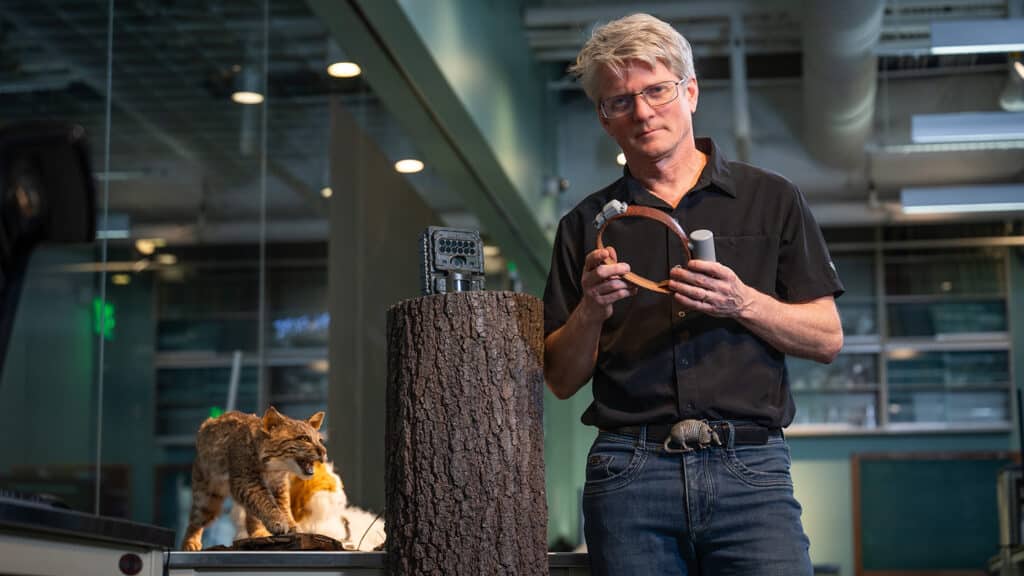
“Our work is very similar to one another’s, but we come at it from different approaches, so we cover each other’s weaknesses,” Kierepka said. “[Kays] tends to be more on the field-based side of things. He does things like putting collars on animals and camera trapping, so genetics is a great complement to that, and vice versa. For example, you can’t use genetics to track an animal, but camera traps can fill in those gaps.”
Through the glass walls of their shared research lab at the museum, visitors can see Kays and Kierepka — and their students — at work. The setup allows for informal interactions with the public.
“Being in an open lab like this, you can really interact with the public in a more personalized and sort of impromptu way, which is really fun,” Kierepka said. “At least a couple of times a week we’ll actually bring people in and have planned events, where we talk to all sorts of groups, primarily school groups. We also interact with guests that are interested. Usually they’ll wave at you and ask to come in and we’ll give them a quick tour.”
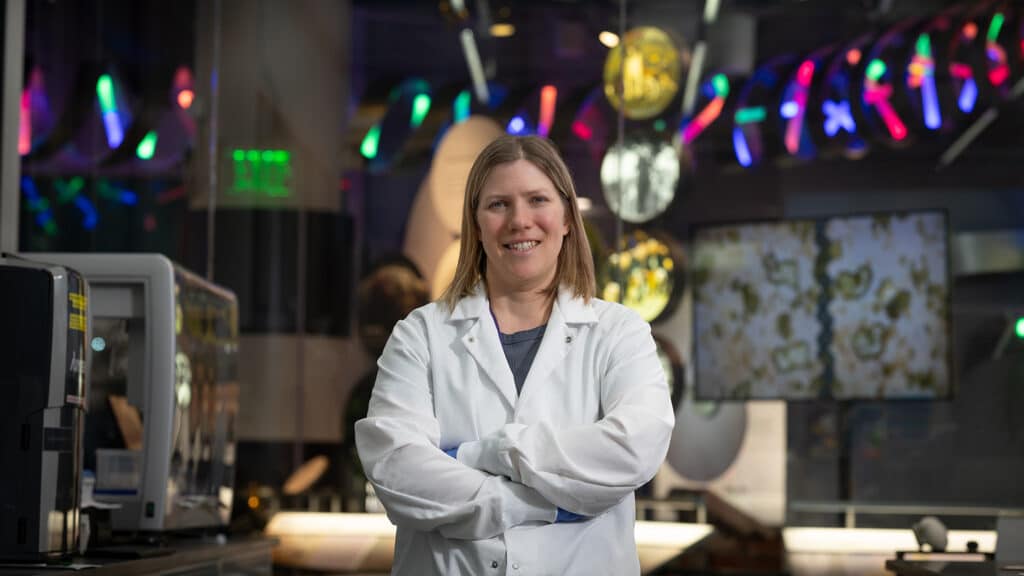
Museum visitors, especially children, can walk away with a better sense of who does scientific research — and how it’s done.
“They’re able to see that we have a diverse group of students and staff working here,” Kays said. “We’ve had kids go, ‘Oh, girls can study bugs!’ And hopefully they’re also taking away a little tidbit about, ‘Oh, they use drones to study wildlife,’ that sort of thing.’”
Having children stop and ask questions has also helped Kays and Kierepka hone their teaching and science communication skills.
“Sometimes kids ask questions that you can’t really answer — one kid asked me how a T. rex could wash its hands after going to the bathroom — but usually they’re really insightful,” said Kierepka. “The biggest thing they help me with is designing my science communication, because I’m able to see right away if I’m being too jargony. That’s also transferable to teaching. I teach a genetics class for students that have no genetics background. Engaging with the public at the museum has given me practice in figuring out how to explain complex topics.”
A Wild Find
In 2013, Kays discovered the Olinguito, a member of the raccoon family that is native to Ecuador and Colombia.
Tracking Biodiversity
Kays helped establish two of the largest biodiversity databases in the world, Movebank and Wildlife Insights.
Delving Into the Drama
On his podcast, Wild Animals, Kays and his guests recount their wildest experiences tracking animals.
The NC State students that work with Kays and Kierepka gain research and science communication skills in the lab at the museum, but they also get their hands dirty — literally — in the field. Each fall, Kays’ students run camera traps at Schenck Forest and Umstead State Park. The data they capture is added to Snapshot USA, a national mammal survey run by Kays.
“The students are involved in running the cameras, so they’re running around the forest getting lost, getting rained on and learning the field experience,” Kays said. “They leave the cameras out for two months and then we process all the images. So now we can look every year at how the populations have changed over time and examine whether they’re going up or down.”
For us as researchers, and for students as well, the museum offers experiences that would be difficult to find in a traditional university environment.
As part of a research project focused on coyotes in the Outer Banks, one of Kierepka’s students has been tasked with collecting fecal samples along North Carolina’s coast. They’ll use the DNA from the samples to estimate the size of the coyote population.
Another perk of working at the museum is having access to the institution’s sizable collection of mammal, bird and geological specimens dating back to the mid-1800s. Kays uses them to study the locality of certain populations of animals over time, while Kierepka uses them for DNA comparison between the same species of animals in different time periods.
“For us as researchers, and for students as well, the museum offers experiences that would be difficult to find in a traditional university environment,” Kierepka said.
Hughes and Smith: Showcasing Biodiversity, Communicating Creatively
While Kays and Kierepka mainly study mammals, entomologist Adrian Smith and ichthyologist Lily Hughes study the critters that crawl beneath our feet and the ones that swim in the streams in our backyards and beyond.
Smith’s research focuses on the behavior and evolution of insects, while Hughes studies fish biodiversity through space and time using genomics and specimens from natural history collections. The creatures Smith and Hughes study are vastly different, but they both focus on showcasing the biodiversity of the respective species they study — and on finding creative ways to do so.
Based in a glass-walled lab at NCMNS, Smith has regular interaction with the public. But communication through visual media is where his passions lie. A lot of his work ends up on his YouTube channel, Ant Lab, which features videos of insects in motion. He estimates he’s captured and published flight sequences of over 100 different species.
“NC State undergraduate students in my lab are involved in most of the videos I put out,” Smith said. “Many of them actually come to work in the lab because they see the content and are interested both in YouTube and the research.”
Most recently, Smith teamed up with artist and photographer Xavi Bou to turn some of the insect flight sequences he’s filmed into photographic images. The project, which debuted in the April 2024 issue of National Geographic, combines art and science to elevate Smith’s and Bou’s overarching mission.
“We both want to give people a new way to see and appreciate the natural world,” Smith said.
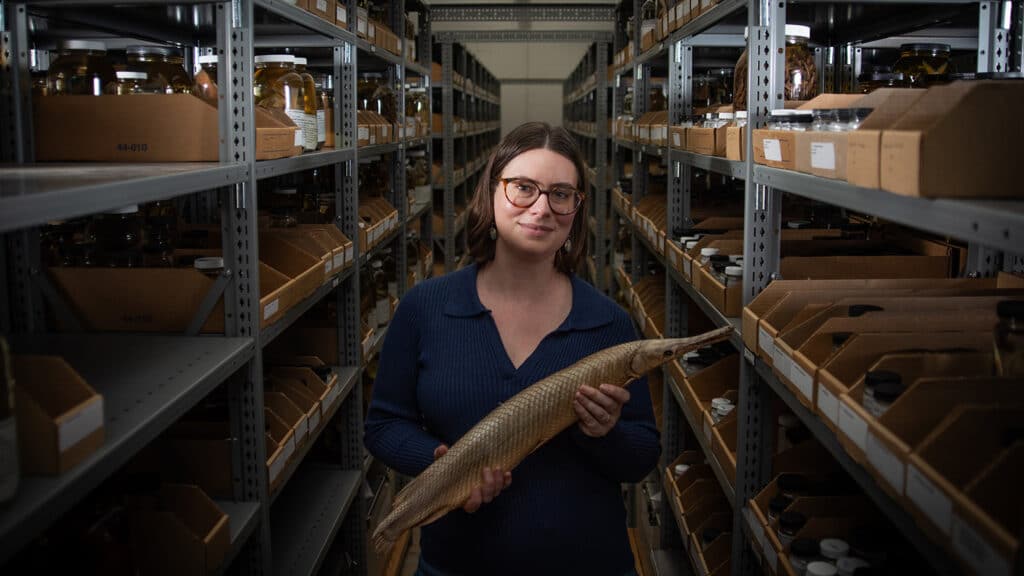
Unlike Smith’s visitor-friendly lab, Hughes’ is tucked away in the Research Laboratory, a museum-owned building with no public access. Housing collections of fish, invertebrate, reptile and amphibian specimens, the building is roughly six miles from the museum. But that doesn’t stop Hughes from constantly finding ways to share her work with the public.
“Since my lab is a little bit more behind-the-scenes, we participate in big museum events. We select fish to showcase based on the theme of the event,” Hughes said. “So, for Halloween events, we pick spookier fishes, like a coffin fish or a Lantern shark, which is a shark that can glow. But for more general events, we try to showcase species that are unique to North Carolina or that have interesting life histories. We want to teach people a little bit about some of the fish that live in their backyard.”
Hughes also involves her students in her work and outreach efforts.
“I often bring my class here when I’m teaching to talk a little bit about doing genetics in a museum setting and what museums bring to that kind of science,” she said.
“We’re trying to get our interns involved in some of our outreach work,” she added. “It’s a great experience for students to get a chance to do that and learn — as an undergraduate or graduate student — how to talk to different audiences, because that’s so important in so many kinds of jobs. Sometimes students think of creative ways to communicate something that I never would’ve thought of, and I really appreciate the different voices they can bring to science communication.”
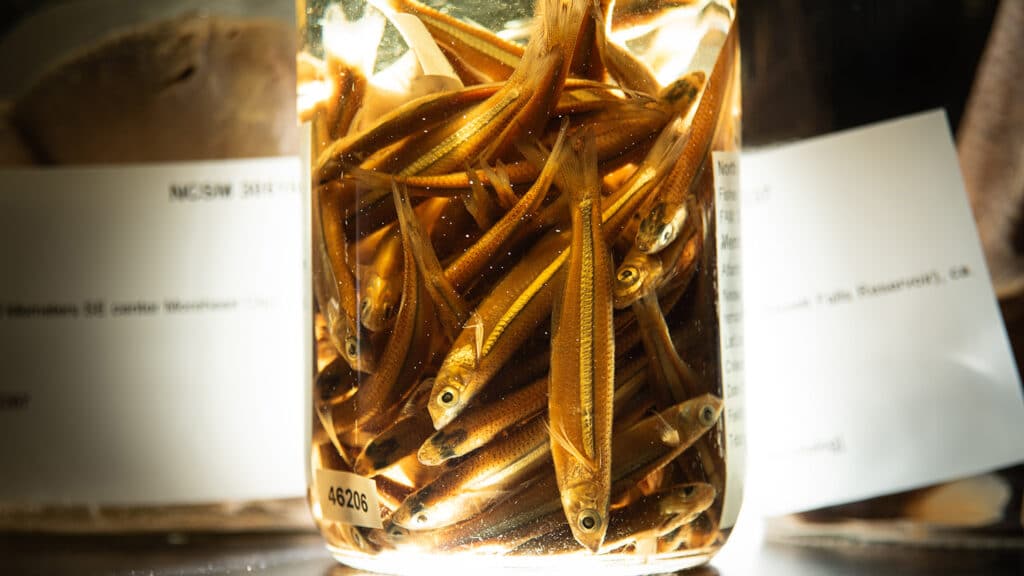
The emphasis on science communication that takes place when scientists and the public have access to each other is hugely beneficial to science and society. For the public, observing research can foster a deeper understanding and appreciation of scientific discovery.
“What I like to impress upon kids is that science is still happening,” Zanno said. “There’s a mistaken idea that we’ve discovered everything there is to know. And I think that comes from a lot of the scientific experiences they have in school, which is doing work to answer a question that they know has already been answered, and that’s just not inspiring.”
For scientists — and scientists-in-training — explaining their research to a variety of audiences helps them connect the work they do within their labs to the wider world.
“One of the things that’s incredible about the partnership is that we’re training the next generations of students at NC State to become storytellers, and to learn to translate science into story so that it can be shared with the public,” Zanno said.
This post was originally published in NC State News.
